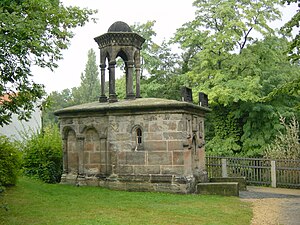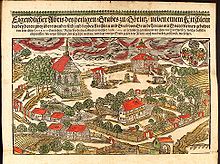Holy grave (Görlitz)
The Holy Sepulcher in Görlitz , also called Görlitzer Jerusalem , was created as a religious total work of art that extends from the crypt of the Church of St. Peter and Paul across the urban area to the Holy Sepulcher. It is one of the main attractions in the city. The Holy Sepulcher Chapel in Neisse City is a scaled-down copy of the Jerusalem original from the high Middle Ages, the accuracy of which has not been achieved in any other replica of the Holy Sepulcher in Germany. The image that it offers in Görlitz was in the same form in front of the crusaders, as did Georg Emmerich , the later mayor, and Agnete Fingerin when they made a pilgrimage to the Holy Land.
In 1989 the 500th anniversary of the Holy Sepulcher in Görlitz was celebrated. The occasion of the celebrations was controversial because the years between 1481 and 1489 are named for the construction of the complex as well as the period between 1481 and 1504.
history
Erected on the late medieval complex as a landscape and architectural ensemble, the double chapel of the Holy Cross, the scaled-down replica of the Moorish-Romanesque Holy Sepulcher and the anointing chapel with a sculpture by Hans Olmützer were created . Designations as disciples meadow, Kidron Valley and the Mount of Olives (see Calvary ) make it clear that the system should be understood as a religious work of art.
More recent research does not clearly prove what is often told as a legend : Georg Emmerich (1422–1507), the son of a wealthy merchant in Görlitz, Studiosus in Dresden, impregnates the daughter of Görlitz's neighbor Benigna Horschel and refuses to marry. The pilgrimage to Jerusalem in 1465 is not only an expression of profound religiosity , it also ends for Emmerich with the absolution of his sins: he is made Knight of the Holy Sepulcher .
The complex is directly dependent on the shrines in the Church of the Holy Sepulcher in Jerusalem. The Kreuzkapelle in Görlitz is a scaled down copy of the high medieval Holy Sepulcher Chapel, which no longer stands in Jerusalem. Construction of the complex began in 1480, when the city council of Görlitz submitted a building application for a stone cruciform chapel to the Bishop of Meissen . As builders are detectable: Conrad Pfluger and his Parliere Urban Laubanisch and Blasius Börer, the latter from 1497 alone. In 1504 the inauguration took place with a mass by the Bishop of Meissen.
architecture
The entire complex consists of the Holy Sepulcher Chapel, the Double Chapel of the Holy Cross with Adam's Chapel (below) and Golgotha Chapel (above) as well as the Salve House, a rectangular housing with a star vault and the sculpture "The Lamentation of Jesus" by Hans Olmützer. The landscape with the hills north of the burial chapel shows the Mount of Olives with the Gethsemane Garden, with the place of prayer and the disciples' meadow. The watercourse symbolizes the valley of the Kidron stream. The streets of the city from the crypt of St. Peter's Church to the complex form the Way of the Cross with various stops for rest.
The late Gothic double chapel is an externally simple rectangular building with a needle-pointed roof turret, which on the high upper floor ( Golgotha chapel ) with tracery windows and rich vaults reproduces the location of the three crosses with three circular depressions in the floor. A channel in the floor is supposed to guide the blood of Christ through an artificially created rock gap in the masonry (reference to the earthquake at the death of Christ or the torn curtain in the temple) to Adam's tomb in the lower chapel. This lower Adam's chapel is designed in the manner of a crypt low with a jagged ribbed vault, which could also be a reference to the earthquake. Given the pronounced realism with which every detail of the Passion story is reproduced here, the entire complex was probably equipped with numerous other props for Passion plays .
Agnes Fingerin
Agnes or Agnete Fingerin (–1515) is one of the few women from the Middle Ages who, after the death (1465) of her rich husband, led an unmarried life for more than 50 years. In 1476 she made a pilgrimage to the Holy Land with Duke Albrecht's travel company , "a woman of manly courage and talking disguised in a monk's habit". She is mentioned in Hans von Mergenthal's travelogues. However, there is no evidence to support the claim that she brought the construction plans for the Görlitz Holy Sepulcher with her from Jerusalem. It is more likely that the planning was based on a contemporary travel description by Bernhard von Breidenbach .
Georg Emmerich
After his pilgrimage, Georg Emmerich becomes a council member of the city of Görlitz and has been elected five times as mayor . In this position Emmerich supports the construction of the Holy Sepulcher. Sources show that the Emmerich family could not take ownership of this facility, according to which the citizens of the city fight for the preservation of the common good. A grandson of Emmerich had an inscription placed in the Adam's Chapel in 1578, which led to the legend that he was the founder of this complex.
From pilgrimage site to tourist attraction
Today the Way of the Cross with the Stations of Passion is the starting point for the resurrection celebration in the Holy Sepulcher. Every year on Good Friday , this event is a highlight - also as a tourist attraction - in the Christian course of the year.
The Way of the Cross leads from the crypt of St. Peter's Church over the biblical stations such as Jesus bakery (which is supposed to mark the place where Jesus collapsed under the weight of the cross), Gethsemane Garden (Mount of Olives), Jesus' prayer area (Jüngerwiese) and the Kidron Valley (Lunitztal) . The neighboring Ölberggarten is to be visited separately in the warm season .
The annual penitential walk of men at the Holy Sepulcher also begins on Good Friday, which leads to one of the four Catholic churches in Görlitz every year.
Association for the preservation of monuments for the Holy Grave in Görlitz eV
According to the statutes of 1987, the association serves to promote the preservation of monuments by supporting the restoration, security and maintenance of the historical buildings, gardens and Gothic works of art around the Holy Sepulcher in Görlitz. The entire ensemble of the Holy Sepulcher including the Way of the Cross through the city is included in the preservation of monuments.
Tourist development
The Holy Sepulcher is a member of the garden culture trail on both sides of the Neisse . This improves the possibilities of care ( park seminars ) and the prospects for funding and tourist development.
literature
- Ines Anders, Marius Winzeler (Ed.): Lausitzer Jerusalem. 500 years of the holy grave in Görlitz. Published for the municipal collections for history and culture Görlitz. Verlag Gunter Oettel, Görlitz et al. 2005, ISBN 3-932693-89-2 , ( Municipal Collections for History and Culture Series NF 38), (publication accompanying the exhibition, Görlitz, Kulturhistorisches Museum, Barockhaus, September 10, 2004 - January 23, 2005 ).
- Till Meinert: The Holy Sepulcher in Görlitz. Architecture and history of a late medieval building ensemble. Rust, Esens 2004, ISBN 3-936492-06-9 (also: Berlin, Freie Univ., Diss., 2002). Review by Christian Speer
- Kai Wenzel: The Bautzen diving church and the Görlitz holy grave. Spatial reorganization of two places of late medieval piety in the denominational age . In: Evelin Wetter (Hrsg.): Formations of the denominational space in East Central Europe. Stuttgart 2008, pp. 167-192.
- Cunerth, Actual Description of the Görlitzischen Holy Sepulcher So probably by means of a correct idea engraved in copper As the following sufficient message of its initial foundation and previous preservation , Goerlitz 1758.
Web links
- official homepage
- The holy grave is not in Görlitz?
- Exhibition of the Kulturhistorisches Museum Görlitz Please scroll down the open page to 11 September 2004 to 22 January 2005 - Lusatian Jerusalem - 500 years of the Holy Sepulcher in Görlitz
- Replica of the Holy Sepulcher in Jerusalem
- The legend about the Emmerich family and the holy grave in Görlitz
- Holy grave on the homepage of the garden culture path on both sides of the Neisse
Individual evidence
- ^ Georg Dehio: Handbook of German Art Monuments. Saxony I. District of Dresden. Deutscher Kunstverlag, Munich 1996, ISBN 3-422-03043-3 , p. 382.
- ↑ Homepage garden culture path on both sides of the Neisse, members and cooperation partners , accessed on June 4, 2018
Coordinates: 51 ° 9 ′ 33.3 " N , 14 ° 58 ′ 57.7" E







